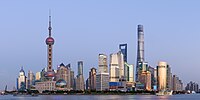
Photo from wikipedia
Environmental degradation, often evidenced by haze, has not only increased the cost of China’s economic development, but its unfair distribution among regional development, social hierarchy, and generations has also reduced… Click to show full abstract
Environmental degradation, often evidenced by haze, has not only increased the cost of China’s economic development, but its unfair distribution among regional development, social hierarchy, and generations has also reduced quality of life. Hence, this study uses cross-sectional data from Didi, a Chinese ridesourcing service company, from 2017 to study the impact mechanism of shared mobility on haze. First, it applies the generalized spatial two-stage least squares model after controlling for urban economic, geographic, transportation, meteorological, and policy variables. We then use urbanization depth (urban agglomeration) and breadth (urban sprawl) variables, which represent the intensity and scope of human activities, respectively, as mediators to test the transmission mechanism from shared mobility to haze. Finally, differences based on urban heterogeneity were tested in the end. The study finds that the scale of ridesourcing and haze show a significant U-shaped relationship: the initial development of ridesourcing has a significant effect on reducing haze, but will then intensify haze as it develops to scales such as those of Beijing and Shenzhen. Moreover, the depth of urbanization is the main transmission mechanism of haze. This conclusion is verified in Tier 3 cities and above; however, the transmission mechanism in Tier 4 and Tier 5 cities is not obvious, indicating that the scale of ridesourcing should be compatible with the scale of urban development. Therefore, the design of emission reduction policies should be considered from the perspective of urban agglomeration.
Journal Title: Environmental Science and Pollution Research
Year Published: 2021
Link to full text (if available)
Share on Social Media: Sign Up to like & get
recommendations!